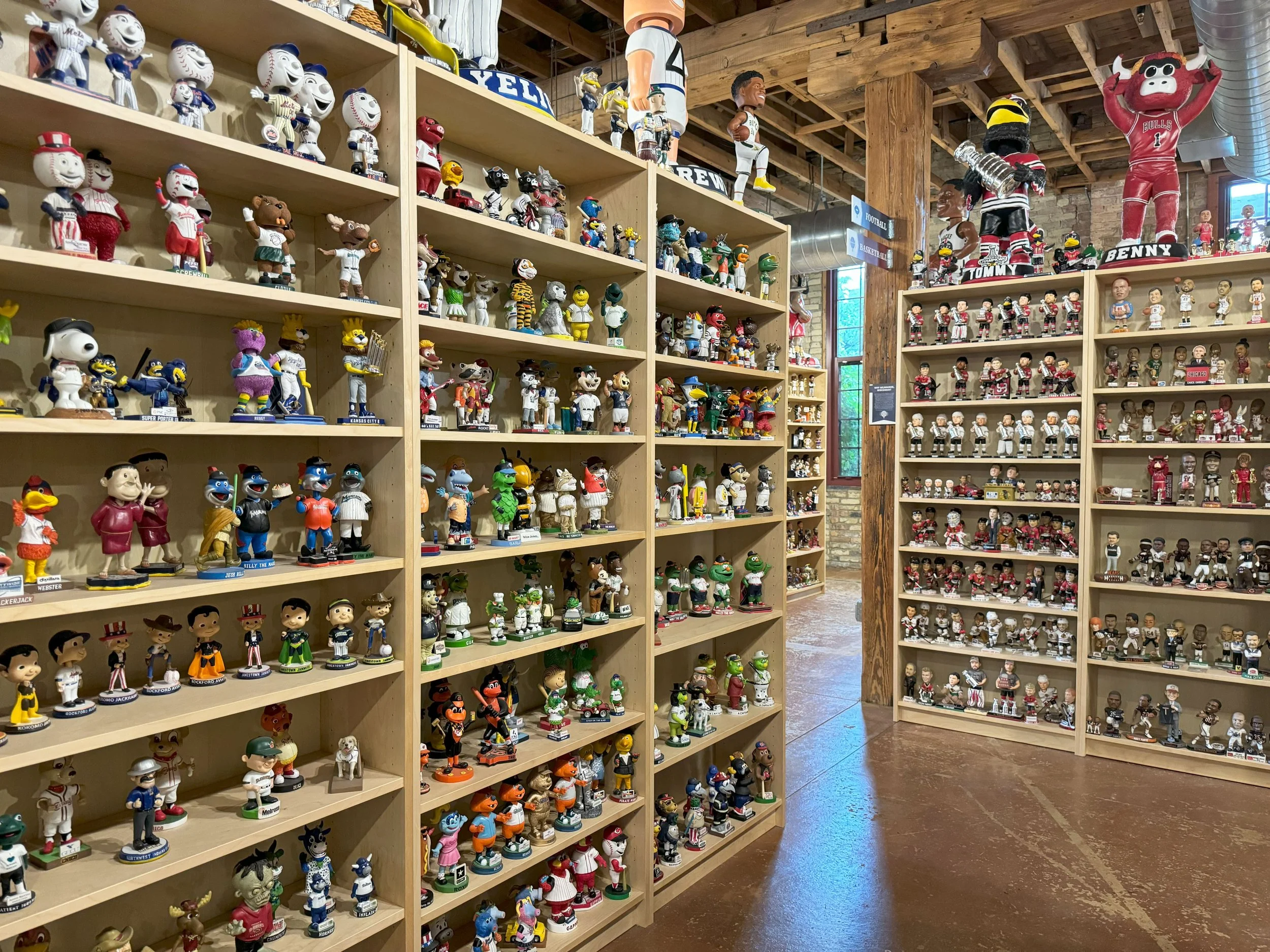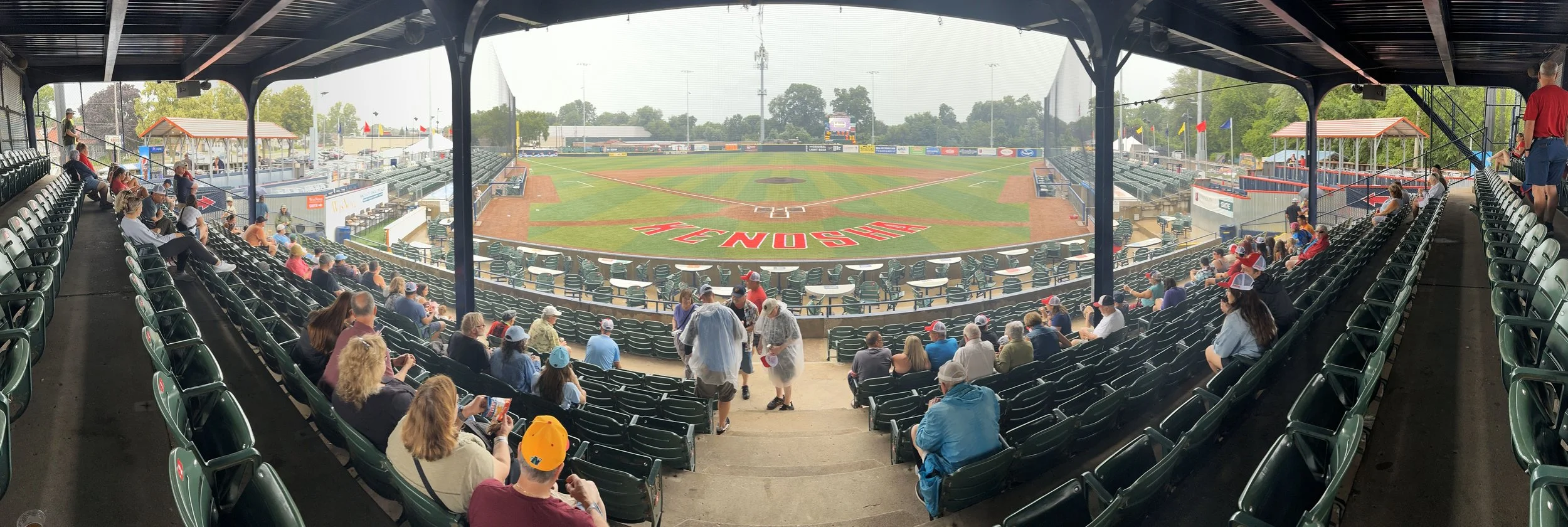Kenosha Kingfish
Dad and I finish our epic, 23-day, 23-ballpark road trip. We stop at the Bobblehead Hall of Fame and Museum in Milwaukee, then continue to Simmons Field in Kenosha, Wisconsin, where we see the Northwoods collegiate summer league Kenosha Kingfish host the Madison Mallards for a wildly wet final game.
Dad and I began the final day of our Eastern Midwest road trip driving south in the direction of Chicago, where we would fly back to our respective home cities that night.
But first, we had a few more sights and a few more innings of baseball to take in, squeezing every possible minute out of another special father-and-son baseball journey through America.
Our path took us through Milwaukee, where we paused for a couple of views of downtown and the Milwaukee Art Museum on Lake Michigan’s Milwaukee Bay. Our original plan had been to visit the museum, but when the scheduling gods gave us a chance to see the Kenosha Kingfish further south, we chose baseball.
Bobblehead Hall of Fame
We did have time, however, for a quick baseball-related museum. Milwaukee’s National Bobblehead Hall of Fame & Museum has a collection of about 10,000 bobbleheads, the largest in the world. Founders Brad Novak and Phil Sklar began to collect wacky wobblers (an actual bobblehead nickname) in 2004, and in 2017 acquired the second-floor space of a building in the Walker’s Point neighborhood of Milwaukee to show off their numerous nodders (another one). The museum opened in 2019.Trying to take in every bobblehead is pure folly. I gravitated to the many baseball sections, and from there to my beloved San Diego Padres, whose heroes were represented in bobblehead form to varying degrees of artistic success.
But the collection does not end with baseball bobblers. Football, basketball, hockey, mascots, announcers, Marvel characters, movie and TV characters, presidents, and much more are represented, each designed to nod most agreeably.
Even Bobby Knight.
I found a few characters Dad and I had encountered on our recent road trips: mascot Scott T. Pippin of the Yakima Valley Pippins; BirdZerk! from a few nights earlier with the Springfield Lucky Horseshoes; and Erik the Peanut Guy (a.k.a. Erik Mertens), the on-field host for the Tri-Cities Dust Devils, who we had seen just the night before at the Wisconsin Timber Rattlers game.
Kenosha
We drove for another hour or so along the shore of Lake Michigan to reach Kenosha, the fourth-largest city in Wisconsin, with a population of about 100,000.Native Americans associated the area with pike. The Potawatomi called it Kenozia ("place of the pike"); the Menominee knew it as Kenūsīw ("Northern Pike"). They fished the Pike River that runs north to south near the shore of Lake Michigan before it turns left into the lake at Kenosha. Americans first named the city Pike Creek, then Southport, and finally, in 1850, Kenosha.
The city’s history is one of immigration, with strong Italian, Danish, German, Polish, and Irish roots. Don Ameche, Orson Welles, Al Molinaro, and Mark Ruffalo were all born in Kenosha.
Kenosha’s economic story is similar to so many Midwestern industrial towns, including being home to major automobile companies — in this case, Nash Motors, Thomas B. Jeffery Co., American Motors, and DaimlerChrysler. This industry and others suffered in the 1980s, as manufacturing jobs went elsewhere, and the town shifted toward a service-based economy.
Kenosha Kingfish
We continued south to Simmons Field and pulled into the parking strip on the third-base side of the ballpark. A light mist began to fall from billowing skies as we walked up to the line forming at the gate.To our left, a brass quintet sheltered under a tent played “I Want You Back” by The Jackson Five. On French horn, the quintet featured Miss Kenosha, Grace Chapa — complete with sash and crown. Chapa had recently also been named Distinguished Senior of the Year at Carthage College, a private Lutheran institution in Kenosha dating to 1847.
Simmons Field opened in 1920 as the home of the Simmons Bedmakers, the company team of Simmons Bedding, founded in Kenosha in 1870 and now a billion-dollar corporation headquartered in Atlanta. The ballpark seated 7,000, but a fire later that year destroyed the grandstand, which would not be rebuilt until 1930. “Rumors persist to this day,” the team’s website states, “that members of the rival Nash Motor Company team started the Simmons Field fire.”
Simmons sold the field in 1947, and the Kenosha Comets of the All-American Girls Professional Baseball League made the ballpark home from 1948-1951 after a stint in Kenosha’s Lake Front Stadium from 1943-1947.
Minor League Baseball came to Kenosha in 1984, when the Single-A Wisconsin Rapids Twins of the Midwest League were sold and moved 200 miles southeast. The Kenosha Twins played through 1992, winning titles in 1983 and 1985 while fostering future Major League stars like Brad Radke, Denny Neagle, Eddie Guardado, and Chuck Knoblauch — not to mention Pat Mahomes. The Twins relocated to Fort Wayne in 1993 to become the Wizards (now the TinCaps).
The semi-pro Kenosha Kings have played at Simmons Field since 1984; a second semi-pro team, the Kenosha Chiefs, played just one season in 1993. The Kenosha Kroakers helped found the collegiate Northwoods League in 1994 before folding in 1998. The Dubois County Dragons of the independent professional Frontier League moved to Kenosha in 2003 as the Mammoths, then migrated to Ozark, Missouri, after a single season.
In 2014, Simmons Field underwent significant renovations for the spawning of the Kenosha Kingfish as a new member of the Northwoods League. It now accommodates up to 3,218 — with 2,100 seats reclaimed from Camden Yards in Baltimore — wrapped around an artificial turf field. The club averaged 2,365 fans per game in 2024, third-best in the 26-team Northwoods League.
The Kingfish have won the league crown once in their 10 seasons, in 2014. A few players from the squad have made it to the majors, including Will Wagner of the Toronto Blue Jays, Danny Young (now with the New York Mets), and Rico Garcia, who played for five MLB clubs.
Rain began to fall in earnest just as we passed through the front gates. Dad and I took refuge in the Kingfish Team Store, where we immediately felt relaxed and comfortable in a familiar habitat.
For my final hat selection of the road trip, I was tempted by the team’s new Kenosha Kickers identity, celebrating the fictional polka band from the movie Home Alone. But I settled on the sharp home cap featuring the colorful Kingfish mascot on a cream background with a navy-blue bill. Oh yes.
I poked my head out from the shelter of the grandstand to get a few photos of the ballpark. I was particularly keen to see The Bambino, a former commercial fishing vessel that forms part of the left-field wall, with the port side of the boat in play. Built in the 1930s, the boat originally worked Chesapeake Bay and is used now as a private party area for up to 25 fans.
The rain really began to pour as I ordered Brats for the both of us — slathered in Stadium Mustard, of course — keeping it simple yet regionally appropriate for our final ballpark meal.
It was Princess Day on this Sunday afternoon at Simmons Field. Disney’s Minnie Mouse, Mirabel, and Elsa looked bright and cheery, in contrast to the gloomy afternoon better reflected in the tortured grin of Kenosha mascot King Elvis the First.
At last, the rain lightened for a bit, offering some hope of starting the game. Players took to the field for warmups in the wet.
The Kingfish had finished the first half of the season below .500 and would put up a similar second-half record. Their opponent for the afternoon, the Madison Mallards, would win the Great Lakes West division in the second half, losing in the playoffs to the eventual Northwoods League champion, the Kalamazoo Growlers.
We were joined at our seats by Joel Van Diggelen, whom we had met in Game 2 of our road trip with the Schaumburg Boomers exactly three weeks and about 200 innings of baseball earlier.
The two managers conferred with umpires and the grounds crew and decided to get the game going in a light sprinkle.
Chapa joined another woman in a French horn rendition of “The Star-Spangled Banner,” and the game was underway.
The Mallards put up a couple of singles in the first but did not score. The Kingfish went down in order in the bottom half.
The rain became heavier and more persistent. Footing on the mound did not appear to be solid, and at least one pitch slipped out of a pitcher’s hands. It was a mess. I thought we would see another delay, but the game kept rolling in the rain.
On the third-base side of the grandstand, I spotted Patrick Noote, one of the driving forces behind the excellent baseballmapper.com. His site — which maps the locations of several hundred ballparks across the U.S., with team names, leagues, and logos — has informed all of my trips and has inspired some of my own maps. Noote had brought his son to the ballpark, and we chatted for a bit in the rain before seeking refuge back at our seats.
We had known all along that our flights wouldn’t allow us to see a full game with the Kenosha Kingfish, and the lengthy rain delay meant we would see even less. The ballgame would go on for another three hours, including a second rain delay, with the Mallards crushing the Kingfish 15-3.
Dad and I hustled through the drizzle to our rental car in the bottom of the second, with the contest still scoreless. Traffic had built up on the interstate going south toward O’Hare Airport, and we would need every minute to return the car, take the shuttle to the terminal, and get to our gate comfortably.
We had done everything we could. That pretty much epitomized the entire journey. In 23 days, we had driven 3,497 to see 25 games in 23 different ballparks. We had watched 34 teams play across eight different leagues, witnessing 232 runs scored in 211 innings of baseball, with 37 home runs, five extra-inning games, and six walk-off wins. We met up with 16 fans and 16 staff members, appeared in three local TV news stories, and were guests on two game broadcasts. I threw out a first pitch and caught two foul balls. We also went to 23 museums, saw five capitol buildings, and went to three historic sights, a national park, and a river tour in the middle of Chicago. Eight of these nights were capped off by fireworks.
We had seized each day, spent priceless time together, learned a lot about this part of America, and celebrated 23 communities gathering together through baseball. Time to start planning again.








